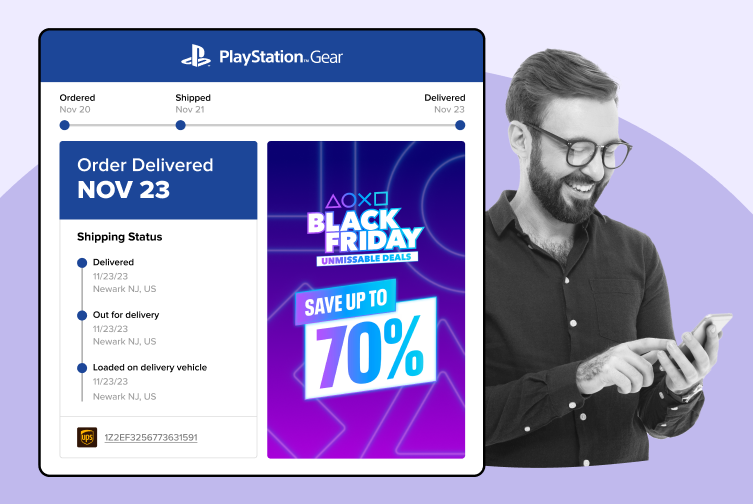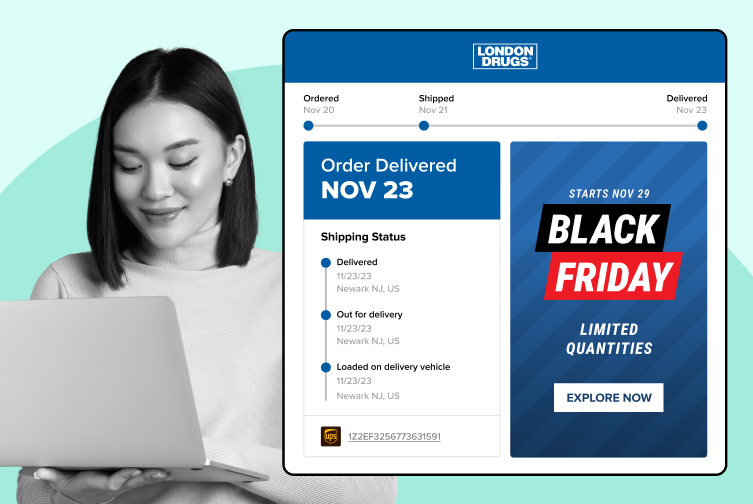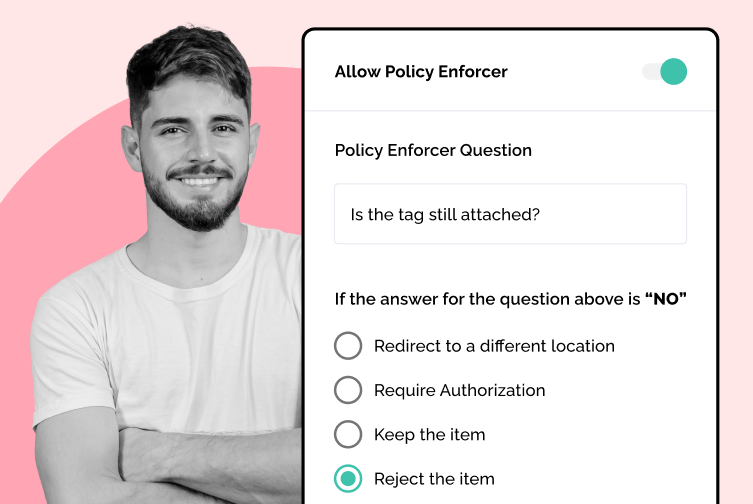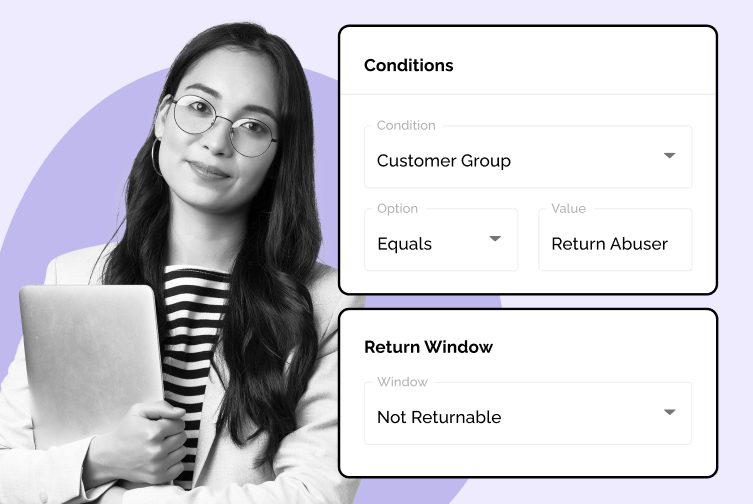
Effective Upselling After Purchase to Increase AOV: Top Strategies
Boost your average order value with effective upselling strategies post-purchase. Discover practical tips to enhance customer satisfaction. Read more!
Shipping, Tracking & Notifications
Boost customer experience and reduce support tickets
Realtime order and shipment tracking
Proactive order and shipping notifications
AI-Enhanced Discounted Labels
Predictive pre-purchase estimated delivery dates
Self-Serivce branded order tracking
Effortless experience delivered
Identify and Resolve Order Issues
Realtime order and shipment tracking
Make returns profitable and delight customers
Flexibility to define any return destinations & conditions
Simplify returns for your customers and team
Incentivize exchanges over returns
Returns management made easy for your team
Returns management made easy for your team
Easy claims and smart upsells
Understand why your customers are returning
In-Store & Curbside Pickup
Unify the online and the in-store experience
Hassle-free pickup experience for customers
In-Store dashboard to keep operations streamlined
In-Store and Online orders unified
Drive foot-traffic to your stores
Shipping, Tracking & Notifications
Boost customer experience and reduce support tickets
Realtime order and shipment tracking
Proactive order and shipping notifications
AI-Enhanced Discounted Labels
Predictive pre-purchase estimated delivery dates
Self-Serivce branded order tracking
Effortless experience delivered
Identify and Resolve Order Issues
Realtime order and shipment tracking
Make returns profitable and delight customers
Flexibility to define any return destinations & conditions
Simplify returns for your customers and team
Incentivize exchanges over returns
Returns management made easy for your team
Returns management made easy for your team
Understand why your customers are returning
In-Store & Curbside Pickup
Unify the online and the in-store experience
Hassle-free pickup experience for customers
In-Store Dashboard to keep operations streamlined
In-Store and Online orders unified
Drive foot-traffic to your stores
Boost customer experience and reduce support tickets
Realtime order and shipment tracking
Proactive order and shipping notifications
AI-Enhanced Discounted Labels
Predictive pre-purchase estimated delivery dates
Self-Serivce branded order tracking
Effortless experience delivered
Make returns profitable and delight customers
Flexibility to define any return destinations & conditions
Simplify returns for your customers and team
Incentivize exchanges over returns
Returns management made easy for your team
Equip your team for precise return checks.
Easy claims and smart upsells
Understand why your customers are returning
Unify the online and the in-store experience
Hassle-free pickup experience for customers
In-Store Dashboard to keep operations streamlined
In-Store and Online orders unified
Drive foot-traffic to your stores
Find the answer to all your questions
Take a step by step trip through our functionality to see how we can improve your ecommerce processes.
Explore the most comon questions about WeSupply
Calculate the ROI that WeSupply can bring you
Read actionable articles on how to optimize your post-purchase experience and decrease support tickets
Get inspired by stories of how our customers implemented an effortless post-purchase experience
Wondering if WeSupply is a good fit for you? Read through our use cases to see how we can help you increase conversion & improve CX!
A Deep Dive into Top Companies' Order Tracking & Returns Strategy
Find the answer to all your questions
Explore the most comon questions about WeSupply
Calculate the ROI that WeSupply can bring you
Request a no strings attached review of your current shopping experience and missed conversion opportunities
Take a step by step trip through our functionality to see how we can improve your ecommerce processes.
Read actionable articles on how to optimize your post-purchase experience and decrease support tickets
Get inspired by stories of how our customers implemented an effortless post-purchase experience
A Deep Dive into Top Companies' Order Tracking & Returns Strategy
Wondering if WeSupply is a good fit for you? Read through our use cases to see how we can help you increase conversion & improve CX!

Shipping is one of the biggest expenses for e-commerce and logistics-driven businesses. Carriers continue to adjust rates, fuel surcharges fluctuate, and customer expectations for fast, affordable delivery have only increased. For many companies, this creates a difficult balancing act: how do you reduce shipping costs without compromising service quality?
The good news is that cost reduction and customer satisfaction don’t need to conflict. By focusing on packaging, logistics, supply chain strategy, technology, and partnerships, businesses can cut expenses while still offering reliable and timely deliveries. The key is adopting a proactive approach that looks beyond quick fixes and builds sustainable, long-term efficiencies. Proactive supply chain strategies are essential for achieving these goals, as they emphasize planning, collaboration, and forward-thinking methods to optimize logistics and reduce costs.
This guide explores proven strategies to help you lower shipping expenses while keeping customers happy.
Cost efficiency is at the heart of successful shipping and logistics operations. As e-commerce and global trade continue to expand, businesses are under increasing pressure to reduce shipping costs while maintaining high service standards. Every dollar saved on shipping expenses directly contributes to the bottom line, making cost efficiency a key driver of profitability and long-term growth.
Achieving significant cost savings starts with a commitment to optimizing shipping operations and eliminating unnecessary costs. By streamlining processes and adopting cost-saving strategies, companies can lower their overall shipping costs and enhance their supply chain performance. This not only improves cost management but also leads to faster, more reliable deliveries boosting customer satisfaction and loyalty.
Effective cost efficiency in shipping is about more than just cutting expenses; it’s about making smart, sustainable choices that strengthen your entire supply chain. By focusing on continuous improvement and leveraging best practices, businesses can stay competitive, deliver value to customers, and achieve substantial cost savings across their shipping operations.
Before you can effectively reduce shipping costs, it’s essential to take a close look at your current shipping practices. A thorough assessment helps uncover hidden inefficiencies and pinpoints opportunities for cost reduction and improved cost efficiency. Start by analyzing your shipping data to identify trends, high-cost areas, and potential waste within your shipping expenses.
Evaluate your choice of shipping carriers, packaging materials, and transportation modes to ensure you’re using the most cost-effective options for your business needs. Leveraging technology, such as transportation management systems, can streamline shipping processes, automate routine tasks, and provide valuable insights for optimizing freight costs. Outsourcing transportation management to specialized providers is another way to access industry expertise and advanced resources, often resulting in lower costs and improved customer satisfaction.
Regular freight audits, especially when conducted by specialized freight audit services, are crucial for identifying billing errors, unnecessary fees, and areas for cost reduction. These audits help ensure you’re only paying for what you need and allow you to optimize freight costs across your logistics operations. By taking a proactive approach to assessing and refining your shipping practices, your business can achieve substantial savings, enhance operational efficiency, and deliver a better experience for your customers.
One of the simplest but most overlooked areas of savings is packaging. Carriers often use dimensional (DIM) weight pricing, which calculates costs based on both weight and size. That means shipping a lightweight product in a large box can cost far more than necessary.
Right-size packaging. Choosing the smallest box or envelope that safely fits the product reduces DIM weight charges. For example, shipping a T-shirt in a poly mailer instead of a corrugated box cuts both shipping and material costs.
Use lightweight materials. Air pillows and packing paper protect items just as effectively as heavier options like bubble wrap or packing peanuts, but they add less weight. Lighter packages mean lower shipping fees.
Adopt cartonization technology. Many businesses are turning to software that recommends the optimal box size for each order. This prevents overspending on oversized packaging and reduces waste.
Buy supplies in bulk. Packaging costs can add up quickly. Purchasing boxes, mailers, tape, and labels in bulk reduces per-unit costs, while keeping a consistent supply ensures operations run smoothly. Sourcing discounted shipping supplies from wholesalers or online marketplaces can further reduce packaging costs, especially when taking advantage of bulk buying or special deals.
Leverage free carrier packaging. USPS, UPS, and FedEx all offer free branded packaging for specific services like flat-rate shipping. Businesses should also seek out and utilize free packaging options provided by carriers to cut costs and promote sustainability. For the right shipments, this is an easy way to eliminate packaging costs entirely.
Well-planned packaging strategies don’t just cut costs. They also improve the customer experience by reducing waste, creating less clutter, and providing items that arrive in good condition. Minimizing packaging waste can also lower waste disposal fees, contributing to overall cost savings.
Transportation costs are the backbone of shipping expenses. The more efficiently you move products, the more money you save. Strategies to reduce transportation costs and manage overall transportation costs are key goals of logistics optimization.
Compare carriers. No single carrier offers the best price for every shipment. USPS may be cheaper for small, lightweight packages, while UPS or FedEx could offer better rates for larger items. Regional carriers often provide competitive pricing for local deliveries. When comparing carriers, it’s important to evaluate the shipping method (ground, air, sea) to find the most cost-effective solution for each shipment. Using shipping software that compares real-time rates across carriers ensures you always choose the most cost-effective option and helps identify the cheapest shipping method for each shipment. Leveraging multiple carriers can further optimize shipping costs and service levels by providing flexibility and access to diverse networks.
Leverage regional and hybrid carriers. Regional carriers like OnTrac or LaserShip specialize in certain geographic areas, often with lower costs and faster transit times. Ground shipping services are a cost-effective option for certain deliveries, especially when using regional carriers. Hybrid services like UPS SurePost and FedEx SmartPost use major carriers for long-distance transport, then transfer to USPS for last-mile delivery, reducing costs for residential shipments.
Optimize delivery routes. Businesses with in-house delivery fleets can benefit from route optimization software. These tools calculate the shortest, most fuel-efficient paths, saving on fuel, labor, and vehicle wear. Optimizing routes can help manage fuel costs and significantly cut fuel surcharges. Even small improvements add up over hundreds of deliveries.
Ship during off-peak times. Carriers often raise rates during peak periods like the holiday season. Encouraging customers to order early or scheduling non-urgent shipments during slower times can avoid surcharges.
Explore multimodal transportation. For long-distance or bulk shipments, using a mix of truck, rail, and ocean freight can significantly reduce expenses. Air freight offers unmatched speed for urgent and time-sensitive deliveries, though it is typically more expensive; balancing speed and cost is essential when choosing between air freight and other modes. While it may add some planning complexity, multimodal transport often balances cost with reliability.
Transportation efficiency comes down to matching the right method with the right shipment, while always keeping customer delivery expectations in mind.
A company’s supply chain directly impacts shipping costs. Poor inventory placement or inefficient logistics networks lead to higher transportation expenses and slower deliveries. Optimizing supply chain operations is essential for controlling shipping costs and improving overall efficiency.
Position inventory closer to customers. Having a single warehouse may be cheap to operate, but shipping across multiple zones inflates costs. By using multiple fulfillment centers or working with a third-party logistics (3PL) network, businesses can place inventory closer to key markets. This reduces transit distance, lowers shipping zones, and speeds up delivery.
Adopt just-in-time inventory management. Holding excess stock in warehouses adds storage costs and increases the likelihood of needing to ship items between facilities. Just-in-time strategies align inventory levels with actual demand, keeping carrying costs and unnecessary shipments lower, and reducing overhead costs by minimizing excess stock and storage needs.
Use supply chain management systems. Modern supply chain software provides visibility into inventory, orders, and shipments, as well as the entire logistics process, helping businesses identify cost-saving opportunities. With real-time insights, businesses can identify inefficiencies and make data-driven adjustments.
Negotiate better terms with suppliers. Partnering with reliable suppliers and carriers creates leverage in negotiations. For example, committing to steady shipping volume can lead to lower rates or priority service by securing discounts based on quantities shipped.
Monitor and adjust strategies. Market conditions and carrier rates change constantly. Regularly reviewing shipping performance and costs ensures you can adapt quickly without letting expenses spiral.
An optimized supply chain doesn’t just save money, it builds resilience and keeps customers satisfied with faster, more reliable deliveries.
Freight costs often account for a large portion of total shipping expenses. Effectively managing freight shipping costs is essential as part of a comprehensive cost reduction strategy. Businesses that ship in bulk or over long distances need targeted strategies to reduce these charges.
Consolidate shipments. Combining multiple smaller orders into a single larger shipment reduces per-unit costs. Grouping multiple shipments by region can lead to bulk shipping discounts, as combining orders leverages economies of scale. This approach can cut trips and maximize truck or container space.
Negotiate bulk discounts. High-volume shippers can secure lower rates by committing to consistent volumes. Even small discounts add up significantly over thousands of shipments.
Use freight audit services. Carrier invoices are often complex, and errors are not uncommon. Freight audits identify overcharges, incorrect billing, or unnecessary fees, helping businesses recover lost funds.
Claim refunds. Carriers typically guarantee on-time delivery. If a shipment arrives late, you may be entitled to a refund. Businesses that track service failures and file claims can recover substantial amounts annually.
Leverage analytics. Using data to track cost per package, delivery zones, and carrier performance provides valuable insights. Analytics support freight cost optimization by enabling data-driven decisions that reduce freight costs and freight expenses. With this information, you can renegotiate contracts, adjust shipment planning, or switch providers.
Maximize truck or container space. Efficient load planning and the use of load optimization tools help maximize space utilization, improving freight efficiency. Strategically arranging cargo reduces the number of trips and lowers fuel costs.
Freight management is about visibility and discipline. Regularly reviewing and optimizing freight operations ensures costs stay under control without harming service reliability. Implementing these strategies can result in significant savings and significant reductions in freight costs.
Shipping policies directly affect both costs and customer expectations. By designing them strategically, you can reduce expenses while still offering value.
Flat-rate shipping. Flat rate shipping options simplify costs for both the business and the customer by providing predictable shipping prices. These options work particularly well for heavier items shipped within certain size limits and help businesses and customers budget more effectively. Understanding and negotiating shipping rates is crucial to improve the cost effectiveness of your shipping policies, ensuring you maximize savings while maintaining service quality.
Free shipping thresholds. Offering free shipping encourages larger orders. By setting a minimum order value, businesses raise their average order value (AOV) and offset the shipping cost. For example, requiring a $50 minimum purchase for free shipping encourages customers to add extra items to their cart.
Flexible delivery options. Not every customer needs next-day delivery. Giving shoppers the choice of slower, cheaper shipping methods provides savings while still offering premium options for those who want speed.
These policies turn shipping from a cost burden into a tool that drives revenue and customer loyalty.
Returns are often an overlooked but major contributor to shipping expenses. Every return means another round of transportation, processing, and potential restocking.
Improve product accuracy. Detailed product descriptions, high-quality photos, and accurate sizing information help customers make informed purchases and reduce the likelihood of returns.
Standardize packaging. Poor packaging leads to damaged goods, which often come back at the seller’s expense. Ensuring consistent, protective packaging minimizes this risk and can significantly reduce product damage, thereby lowering return shipping costs.
Enhance communication. Customers who understand return policies and shipping expectations are less likely to send items back unnecessarily. Clear communication builds trust and reduces reverse logistics costs.
By preventing unnecessary returns, businesses not only save on shipping but also improve customer satisfaction and loyalty.
Combat inconvenience with proactivity & self service
Book a quick call with our experts to see how WeSupply can help you make returns easy for your customers with a beautiful, self-service solution that makes their experience easier while also providing new ways to lower costs and earn back revenue.
Technology is one of the most powerful enablers of shipping cost reduction. It provides visibility, automation, and predictive insights that drive efficiency.
Automate shipping tasks. Software can generate labels, compare rates, and track shipments automatically. This reduces manual errors and saves time.
Use a transportation management system (TMS). A transportation management system integrates with carriers and warehouses, helping businesses select the most efficient carriers, routes, and shipping modes. TMS platforms support freight cost optimization and help optimize shipping costs by streamlining logistics, improving visibility, and enabling data-driven decisions.
Leverage predictive analytics. Accurate demand forecasting prevents costly expedited shipments and stockouts. Advanced predictive pricing models within a TMS help anticipate rate changes, enable better rate forecasting, and allow businesses to adjust strategies early for cost savings.
Adopt warehouse automation. Automated picking, packing, and sorting reduce labor costs and speed up order fulfillment. Faster, error-free fulfillment translates to lower costs and higher customer satisfaction.
Analyze shipping data. Tracking key performance metrics such as cost per order, delivery times, and carrier performance uncovers inefficiencies and informs smarter decision-making for continuous improvement.
When used effectively, technology turns shipping into a controllable, predictable cost center instead of a constant challenge. These technology-driven strategies can also improve cash flow by reducing operational expenses and increasing efficiency.
Not every company has the resources or expertise to manage logistics in-house. Outsourcing can reduce costs while ensuring professional service quality. For many businesses, outsourcing logistics functions and partnering with experts are effective cost saving measures that help scale operations efficiently.
Third-party logistics (3PL) providers. 3PLs operate large networks of warehouses, fulfillment centers, and carrier relationships. They pass on discounted rates from their scale and provide access to advanced logistics technology.
Outsource transportation management. Partnering with transportation management experts allows businesses to focus on core operations while accessing specialized cost-control strategies.
Collaborate with carriers and suppliers. Building long-term relationships encourages carriers to offer better pricing and priority service. Collaboration can also lead to joint solutions that improve efficiency.
Leverage partnerships for innovation. Many logistics partners provide access to new tools, delivery models, and optimization methods that would be expensive to implement independently.
The right partnerships provide both cost savings and service improvements, creating a win-win scenario.
Accessorial fees are additional charges carriers apply for services like fuel, oversized packages, residential delivery, or Saturday delivery. Left unmanaged, they can inflate shipping bills significantly.
Understand common fees. Knowing which services trigger extra charges helps you avoid them when possible. For example, shipping a package slightly under the oversized threshold prevents costly penalties.
Negotiate fees. High-volume shippers can often negotiate reduced or waived accessorial charges. Carriers are willing to adjust terms for consistent, loyal partners.
Use technology for monitoring. Shipping platforms can track fees across invoices and highlight patterns of overcharges or unnecessary services. Tracking accessorial fees also helps businesses better understand and manage their average shipping cost, making it easier to plan and control typical expenses.
Audit invoices regularly. Frequent reviews ensure you catch billing errors or unexpected fees early.
Managing accessorial fees is a straightforward way to trim costs without affecting delivery speed or reliability.
Reducing shipping costs without sacrificing service is a challenge every eCommerce brand faces. With WeSupply, you gain the tools to cut expenses, streamline logistics, and keep customers happy, all in one platform.
Here’s how WeSupply helps you reduce shipping costs while improving service:
AI-Enhanced Discounted Labels: Save up to 83% on shipping with instant access to discounted carrier rates—no contracts or volume minimums.
Easy Rate Comparison: Compare real-time rates across 100+ carriers and always choose the most cost-effective option.
Smart Shipping Tools: Auto-fill labels, bulk print, and integrate directly with your store to eliminate manual errors and wasted time.
Real-Time Tracking & Notifications: Reduce WISMO calls with branded tracking pages, proactive alerts, and SMS/email updates.
Proactive Delay Management: Identify stalled, delayed, or undeliverable shipments early and resolve them before they impact customer trust.
Analytics & Insights: Get SKU-level returns data and shipping cost reports to refine packaging, delivery strategies, and carrier choices.
Global Scalability: Ship internationally, leverage regional carriers, and stay resilient even during carrier strikes or peak-season surcharges.
Seamless Integrations: Connect your eCommerce platform and automate every step, from order to final delivery.
With WeSupply, shipping becomes smarter, faster, and more affordable. You lower operational costs, strengthen your supply chain, and deliver a seamless customer experience that builds loyalty.
👉 Launch as soon as tomorrow. Schedule a demo and see how WeSupply can transform your shipping strategy.
Reducing shipping costs is about efficiency, not shortcuts. By optimizing packaging, improving supply chain management, streamlining transportation, and cutting unnecessary returns, you can save 10–30% while keeping service levels high.
Technology plays a key role, and this is where WeSupply helps. With real-time tracking, automated updates, branded notifications, and analytics, you gain visibility and control that keeps customers informed and reduces service costs. WeSupply also simplifies returns, exchanges, and shipping label generation, turning logistics into a driver of customer loyalty. When you combine smart strategies with WeSupply’s tools, you lower expenses, speed up deliveries, and improve satisfaction.
In today’s competitive market, the ability to reduce costs without sacrificing service is what sets successful ecommerce businesses apart.
Returns Analytics for eCommerce Business
Book a quick call with our experts to see how WeSupply can help you understand why your customers are returning: Identify the most returned products, Understand why those products are returned, Identify which customers are serial returners, Reduce Return Rate with Actionable Insights, Returns data available in BigQuery.
1. How can businesses reduce shipping costs without hurting customer service?
Businesses can cut shipping costs by right-sizing packaging, comparing carriers, optimizing delivery routes, and using technology for automation and tracking while maintaining fast, reliable delivery.
2. What is the most effective way to lower packaging costs?
Right-size boxes, use lightweight materials, adopt cartonization software, and leverage free carrier packaging. These steps reduce DIM weight charges and material expenses.
3. Why is supply chain management important for reducing shipping costs?
Placing inventory closer to customers, using multiple fulfillment centers, and adopting just-in-time strategies reduce transportation zones, lower costs, and improve delivery speed.
4. How does WeSupply help reduce shipping costs?
WeSupply provides discounted labels, carrier rate comparisons, and smart automation tools that lower operational costs while keeping deliveries fast and reliable.
5. Can WeSupply improve customer experience while cutting costs?
Yes. WeSupply offers branded tracking pages, proactive alerts, and real-time notifications that reduce WISMO calls, improve transparency, and maintain service quality.
6. Does WeSupply support global shipping cost reduction?
Yes. WeSupply connects to 100+ carriers, including regional and international options, helping businesses manage costs while scaling globally.
7. Does WeSupply have an Official Shopify App?
Yes. WeSupply has an Official Shopify App. You can download it and start integrating with your Shopify Store.
8. Does WeSupply have an official Magento extension?
Yes, WeSupply has an official extension for Magento. The WeSupply x Magento integration allows for automating order tracking experiences, reducing customer inquiries, automating shipping email and SMS notifications, and providing a fully branded order tracking experience.
9. Does WeSupply have an official BigCommerce App?
Yes, WeSupply has an official BigCommerce App. You can integrate WeSupply with your BigCommerce store to improve your post-purchase customer experience.
Learn How To Create Successful Post Purchase Email Campaigns
Build an effective post-purchase email flow that helps you increase customer satisfaction and drive revenue growth!

Boost your average order value with effective upselling strategies post-purchase. Discover practical tips to enhance customer satisfaction. Read more!

Discover effective strategies to enhance ecommerce revenue retention and foster customer loyalty. Read the article to elevate your business success.

Discover how to analyze returns data to reduce return rates and boost profitability. Learn effective strategies to enhance your business’s performance.

Discover effective methods for analyzing customer feedback post-purchase. Enhance satisfaction and drive improvement!

Learn effective strategies to combat wardrobing and tag switching in fashion ecommerce. Protect your business and enhance customer trust. Read more now!

Learn how to manage BOGO returns effectively while ensuring customers aren’t charged for the free item. Practical solutions!

Explore how automation and data can enhance your shipping strategy. Discover best practices to stay competitive and efficient. Read the article now!

Discover effective strategies to prevent return promo abuse with smart logic. Enhance your business’s integrity!

Learn how to effectively manage promo bundle returns while protecting your revenue. Discover practical tips to streamline your process!